|
On November 3,
2009 there were
1077
potentially
hazardous
asteroids.
Nov. 2009
Earth-asteroid
encounters:
Notes: LD
means "Lunar
Distance." 1 LD =
384,401 km, the
distance between
Earth and the Moon.
1 LD also equals
0.00256 AU. MAG is
the visual magnitude
of the asteroid on
the date of closest
approach.
|
On
December
14,
2009
there
were
1086
potentially
hazardous
asteroids.
Dec.
2009
Earth-asteroid
encounters:
| Asteroid |
Date(UT)
|
Miss Distance
|
Mag.
|
Size
|
| 2009 WV25 |
Dec. 1
|
2.9 LD
|
16
|
65 m
|
| 2009 WA52 |
Dec. 5
|
8.2 LD
|
20
|
23 m
|
| 2002 WP |
Dec. 6
|
71.2 LD
|
16
|
950 m
|
.
|
|
|
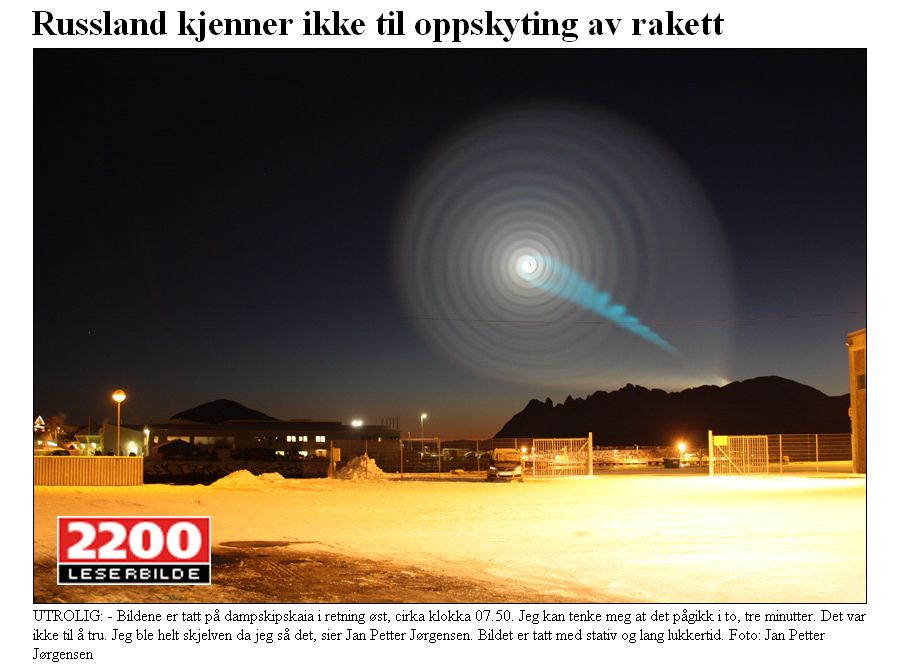
SKY
SPIRAL OVER NORWAY
DECEMBER 9, 2009
TOWARD THE END OF TIME
IT'S THE DANGER OF THE SUN
Explore the Sunspot Cycle
12-31-09 - Sunspot 1039
Current conditions
Solar
wind
speed: 276.9 km/sec
density: 2.3 protons/cm3
explanation |
more data
Updated: Today at 0555 UT
X-ray
Solar Flares
6-hr max: B2
2300
UT Dec30
24-hr: B2
2300
UT Dec30
explanation |
more data
Updated: Today at: 2355 UT
SUNSPOT SURGE:
2009 is ending with a flurry of
sunspots. Indeed, if sunspot 1039
holds together just one more day
(prediction: it will), the month of
December will accumulate a total of
22 spotted days and the final tally
for the year will look like this:
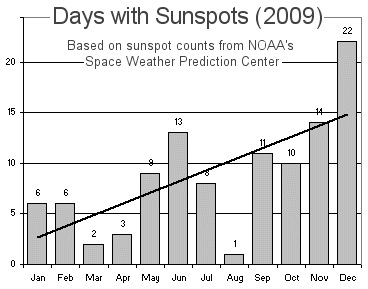
The dark line is a linear
least-squares fit to the data. If
the trend continues exactly as shown
(prediction: it won't), sunspots
will become a non-stop daily
occurance no later than February
2011. Blank suns would cease and
solar minimum would be over.
If the past two years have taught
us anything, however, it is that the
sun can be tricky and unpredictable.
PARTIAL LUNAR
ECLIPSE: On
Dec. 31st, the Moon will dip
into Earth's shadow for a
partial lunar eclipse. The
event is visible from
Europe, Africa and Asia. At
maximum eclipse, around
19:24 UT, approximately 10%
of the Moon will be darkly
shadowed. [animated
preview] [visibility
map] |
|
12-30-09 - Sunspot 1039
Current conditions
Solar wind
speed: 278.4 km/sec
density: 1.8 protons/cm3
explanation |
more data
Updated: Today at 2345 UT
X-ray Solar Flares
6-hr max: B2
2300 UT Dec30
24-hr: B2
2300 UT Dec30
explanation |
more data
Updated: Today at: 2340 UT
|
12-29-09 - Sunspot 1039
Current conditions
Solar wind
speed: 279.6 km/sec
density: 0.9 protons/cm3
explanation |
more data
Updated: Today at 2344 UT
X-ray Solar Flares
6-hr max: A8
2120 UT Dec29
24-hr: A8
2120 UT Dec29
explanation |
more data
Updated: Today at: 2340 UT
|
|
12-28-09 New sunspot 1039
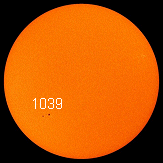
SIGNS OF LIFE ON THE SUN:
2009 is ending with a flurry of
sunspots. So far this month, the
visible disk of the sun has had
spots 67% of the time, a sharp
increase compared to the annual
average. Furthermore, all six of
December's sunspot groups have been
members of new Solar Cycle 24. These
numbers could herald the sun's
awakening from the deepest solar
minimum in nearly a century and a
livelier sun in 2010.
Current conditions
Solar
wind
speed: 335.4 km/sec
density: 1.8 protons/cm3
explanation |
more data
Updated: Today at 1847 UT
X-ray
Solar Flares
6-hr max: A3
1310
UT Dec28
24-hr: A3
0640
UT Dec28
explanation |
more data
Updated: Today at: 1840 UT
|
| 12-27-09 - Sunspot 1039 appears
SOLAR ACTIVITY
INTENSIFIES:
2009 is ending with a flurry
of sunspots. The latest is
sunspot 1039, which formed
yesterday and is now
crackling with low-level
solar flares. Cai-Uso Wohler
sends this picture of a
B-class eruption from
his backyard observatory in
Bispingen, Germany:
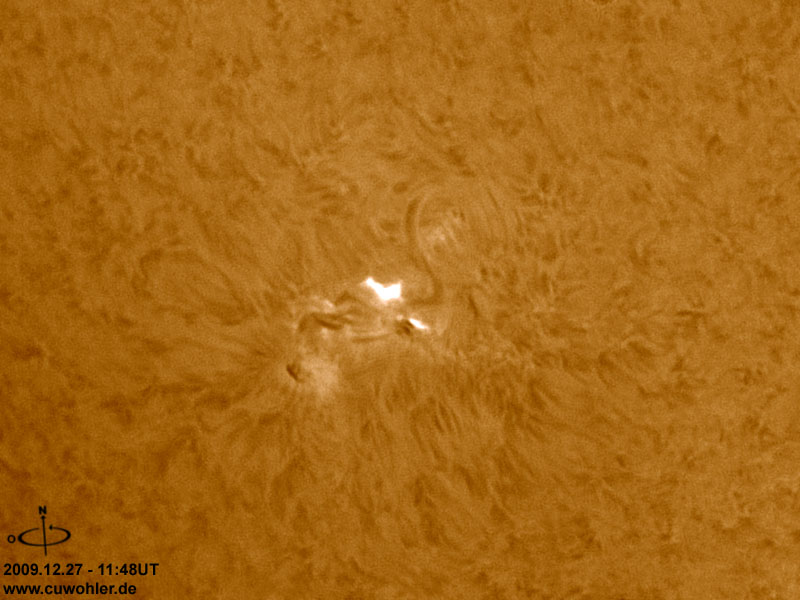
So far, 65%
of the days in December have
brought sunspots--a sharp
increase in percentages
compared to earlier months
of 2009 when sunspots were
surpassingly rare. All six
of December's sunspot groups
have been members of new
Solar Cycle 24. These
numbers could herald the
sun's awakening from the
deepest solar minimum in
nearly a century and a
livelier sun in 2010.
Stay tuned.
more
images:
from Peter Paice of
Belfast, Northern Ireland;
from Marco Vidovic of
Stojnci, Slovenia;
from Stephen Ames of
Hodgenville, Kentucky
Current conditions
Solar wind
speed: 362.6 km/sec
density: 1.5 protons/cm3
explanation |
more data
Updated: Today at 2345 UT
X-ray Solar Flares
6-hr max: A6
1745 UT Dec27
24-hr: B7
1140 UT Dec27
explanation |
more data
Updated: Today at: 2340 UT
|
12-26-09 - There are no sunspots
Current conditions
Solar
wind
speed: 403.0 km/sec
density: 3.7 protons/cm3
explanation |
more data
Updated: Today at 1105 UT
X-ray
Solar Flares
6-hr max: B1
0910
UT Dec26
24-hr: B1
0910
UT Dec26
explanation |
more data
Updated: Today at: 1105 UT
CLOUDS ON MARS:
Earth and Mars are
converging for a close
encounter at the end of
January 2010. At closest
approach on Jan. 27th, the
two planets will be 99
million km (0.66 AU) apart
and Mars will shine like a
bright orange star high in
the midnight sky. Although
the best views are more than
a month away, it is already
possible to see beautiful
details through backyard
telescopes.
Emil Kraaikamp sends
this image from Ruinerwold,
The Netherlands:
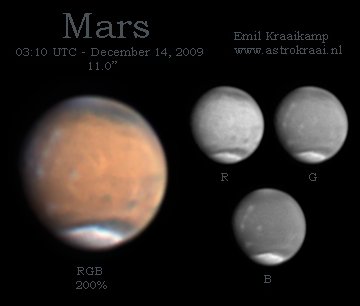
Click to launch a 2.7 hour
time-lapse movie
"I took the
picture using a 10-inch
Meade Starfinder," says
Kraaikamp. The planet's most
eye-catching feature is the
huge polar ice cap, but
Kraaikamp points out
something else: "Sometimes,
pale blue
orographic clouds can be
seen hovering above ancient
volcanoes on Mars. In this
image, the clouds are
present over Arsia Mons,
Pavonis Mons, Ascraeus Mons,
and the biggest volcano of
all, Olympus Mons." They are
particularly conspicuous in
this animation of Mars
rotating.
The view
will only improve in the
weeks ahead.
|
12-25-09 - There are no sunspots today
Current conditions
Solar wind
speed: 373.9 km/sec
density: 7.9 protons/cm3
explanation |
more data
Updated: Today at 2343 UT
X-ray Solar Flares
6-hr max: A9
2325 UT Dec25
24-hr: B1
0330 UT Dec25
explanation |
more data
Updated: Today at: 2340 UT
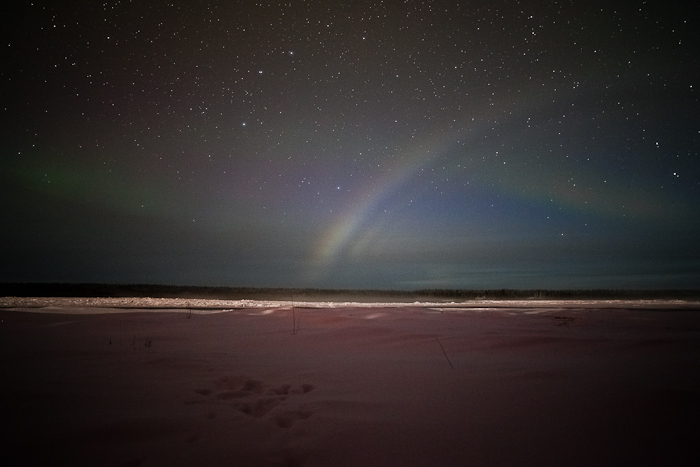
AURORAS AND
A RAINBOW AT
NIGHT:
At midnight
on Dec.
23rd, Karl
Johnston
found
himself
climbing
down a cliff
on the banks
of the Slave
River, near
Fort Smith
in the
Northwest
Territories
of Canada.
He paused
for breath,
looked out
over the
rapids, and
this is what
he saw:
"A rainbow
was cutting
through the
aurora
borealis,"
he says.
A
rainbow at
night?
"Moonlight
was shining
into the
mist above
the
rapids--and
that's what
made the
rainbow," he
explains.
Technically,
it's called
a fogbow.
Fogbows
are
close
cousins
of rainbows
and they are
formed
in
essentially
the same
way: light
bounces in
and out of
water
droplets to
produce a
luminous
arc.
Johnston's
lunar fogbow
formed above
the rapids
just as a
solar wind
stream was
buffeting
Earth's
magnetic
field,
giving rise
to auroras
and a rare
conjunction
of Arctic
night
lights. It's
enough to
make you
scale a
cliff at
midnight.
More
images:
#1,
#2,
#3.
UPDATED:
December
Northern
Lights
Gallery
|
12-24-09 - sunspots 1036 - 1038
Current conditions
Solar
wind
speed: 349.4 km/sec
density: 3.3 protons/cm3
explanation |
more data
Updated: Today at 0033 UT
X-ray
Solar Flares
6-hr max: A7
2000
UT Dec24
24-hr: A8
0250
UT Dec24
explanation |
more data
Updated: Today at: 2355 UT
Voyager Makes an
Interstellar Discovery
12.23.2009
December 23, 2009:
The solar system is passing through
an interstellar cloud that physics
says should not exist. In the Dec.
24th issue of
Nature, a
team of scientists reveal how NASA's
Voyager spacecraft have solved the
mystery.
"Using
data from Voyager, we have
discovered a strong magnetic field
just outside the solar system,"
explains lead author Merav Opher, a
NASA Heliophysics Guest Investigator
from George Mason University. "This
magnetic field holds the
interstellar cloud together and
solves the long-standing puzzle of
how it can exist at all."
Voyager
flies through the outer bounds of
the heliosphere en route to
interstellar space. A strong
magnetic field reported by Opher et
al in the Dec. 24, 2009, issue of
Nature is delineated in yellow.
Image copyright 2009, The American
Museum of Natural History.

The discovery has implications for
the future when the solar system
will eventually bump into other,
similar clouds in our arm of the
Milky Way galaxy.
Astronomers call the cloud we're
running into now the Local
Interstellar Cloud or "Local Fluff"
for short. It's about 30 light years
wide and contains a wispy mixture of
hydrogen and helium atoms at a
temperature of 6000 C. The
existential mystery of the Fluff has
to do with its surroundings. About
10 million years ago, a cluster of
supernovas exploded nearby, creating
a giant bubble of million-degree
gas. The Fluff is completely
surrounded by this high-pressure
supernova exhaust and should be
crushed or dispersed by it.
"The observed temperature and
density of the local cloud do not
provide enough pressure to resist
the 'crushing action' of the hot gas
around it," says Opher.
So how does the Fluff survive? The
Voyagers have found an answer.
"Voyager data show that the Fluff is
much more strongly magnetized than
anyone had previously
suspected—between 4 and 5 microgauss*,"
says Opher. "This magnetic field can
provide the extra pressure required
to resist destruction."
 * *
The Local Interstellar
Cloud
Illustration Credit & Copyright:
Linda Huff (American
Scientist),
Priscilla Frisch (U.
Chicago)
Explanation: The stars are
not alone. In the disk of our
Milky Way Galaxy about 10
percent of visible matter is in the
form of gas, called the
interstellar medium (ISM). The
ISM is not uniform, and shows
patchiness even near our
Sun. It can be quite difficult
to detect the
local ISM because it is so
tenuous and emits so little light.
This mostly
hydrogen gas, however, absorbs
some very specific colors that can
be detected in the light of the
nearest stars. A working map of
the local
ISM within 10 light-years based
on recent observations is
shown above. These observations
show that our Sun is moving through
a
Local Interstellar Cloud as this
cloud flows outwards from the
Scorpius-Centaurus Association
star forming region. Our Sun may
exit the
Local Interstellar Cloud during
the next 10,000 years. Much remains
unknown about the local
ISM, including details of its
distribution, its origin, and how it
affects the
Sun and the
Earth.
Above: An artist's
concept of the Local Interstellar
Cloud, also known as the "Local
Fluff." Credit: Linda Huff (American
Scientist) and Priscilla Frisch
(University of Chicago) [more]
NASA's two Voyager probes have been
racing out of the solar system for
more than 30 years. They are now
beyond the orbit of Pluto and on the
verge of entering interstellar
space—but they are not there yet.
"The Voyagers are not actually
inside the Local Fluff," says Opher.
"But they are getting close and can
sense what the cloud is like as they
approach it."
The Fluff is held at bay just beyond
the edge of the solar system by the
sun's magnetic field, which is
inflated by solar wind into a
magnetic bubble more than 10 billion
km wide. Called the "heliosphere,"
this bubble acts as a shield that
helps protect the inner solar system
from galactic cosmic rays and
interstellar clouds. The two
Voyagers are located in the
outermost layer of the heliosphere,
or "heliosheath," where the solar
wind is slowed by the pressure of
interstellar gas.
Voyager 1 entered the heliosheath in
Dec. 2004; Voyager 2 followed almost
3 years later in Aug. 2007. These
crossings were key to Opher
et
al's discovery.

The anatomy
of the heliosphere. Since this
illustration was made, Voyager 2 has
joined Voyager 1 inside the
heliosheath, a thick outer layer
where the solar wind is slowed by
the pressure of interstellar gas.
Credit: NASA/Walt Feimer. [larger
image]
The size of the heliosphere is
determined by a balance of forces:
Solar wind inflates the bubble from
the inside while the Local Fluff
compresses it from the outside.
Voyager's crossings into the
heliosheath revealed the approximate
size of the heliosphere and, thus,
how much pressure the Local Fluff
exerts. A portion of that pressure
is magnetic and corresponds to the
~5 microgauss Opher's team has
reported in
Nature.
The fact that the Fluff is strongly
magnetized means that other clouds
in the galactic neighborhood could
be, too. Eventually, the solar
system will run into some of them,
and their strong magnetic fields
could compress the heliosphere even
more than it is compressed now.
Additional compression could allow
more cosmic rays to reach the inner
solar system, possibly affecting
terrestrial climate and the ability
of astronauts to travel safely
through space. On the other hand,
astronauts wouldn't have to travel
so far because interstellar space
would be closer than ever. These
events would play out on time scales
of tens to hundreds of thousands of
years, which is how long it takes
for the solar system to move from
one cloud to the next.
"There could be interesting times
ahead!" says Opher.
To read the original research,
look in the Dec. 24, 2009, issue of
Nature for Opher et al's article, "A
strong, highly-tilted interstellar
magnetic field near the Solar
System."
Author:
Dr. Tony Phillips | Credit:
Science@NASA
Voyager Mission Home Page
*What
is a microgauss? -- A
microgauss is one millionth of a
gauss, a unit of magnetic field
strength popular among
astronomers and geophysicists.
Earth's magnetic field is about
0.5 gauss or 500,000 microgauss.
Merav Opher –associate
Professor, George Mason
University
Anatomy of the Heliosphere
|
| 12-23-09 - sunspots 1036 - 1036
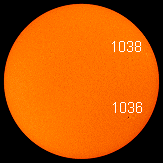
Sunspots
1036 and 1038 are members of new Solar Cycle 24.
Image credit: SOHO/MDI
SOLAR ACTIVITY:
The sun is showing signs of
life. There are no fewer than five
active regions on the sun's surface,
shown here in an extreme ultraviolet
photo taken this morning by the
Solar and Heliospheric Observatory
(SOHO):
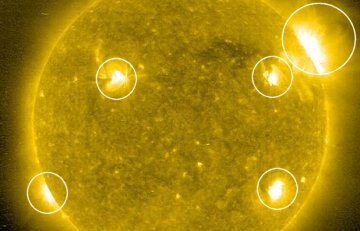
Each circle contains
a sunspot or proto-sunspot belonging
to new Solar Cycle 24. After two
years of record-low sunspot numbers
and many month-long stretches of
utter quiet, this is a notable
outbreak. Whether it heralds a
genuine trend or merely marks a
temporary, statistical uptick in
activity remains to be seen. Stay
tuned!
Current conditions
Solar
wind
speed: 345.3 km/sec
density: 10.5 protons/cm3
explanation |
more data
Updated: Today at 0534 UT
X-ray
Solar Flares
6-hr max: C1
2225
UT Dec22
24-hr: C6
0455
UT Dec22
explanation |
more data
Updated: Today at: 2355 UT
|
| 12--22-09 sunspots - 1036-1038
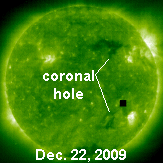
A solar
wind stream flowing from the indicated coronal
hole could reach Earth on or about Dec. 23rd.
Credit: SOHO Extreme UV Telescope
Current
conditions
Solar wind
speed: 340.5 km/sec
density: 6.1 protons/cm3
explanation |
more data
Updated: Today at 2344 UT
X-ray Solar
Flares
6-hr max: C1
2225 UT Dec22
24-hr: C6
0455 UT Dec22
explanation |
more data
Updated: Today at: 2340 UT
|
| 12-21-09 sunspots - 1035-1036-1037
Current
conditions
Solar wind
speed: 361.4 km/sec
density: 4.8 protons/cm3
explanation |
more data
Updated: Today at 2345 UT
X-ray Solar
Flares
6-hr max: B2
2335 UT Dec21
24-hr: C2
0715 UT Dec21
explanation |
more data
Updated: Today at: 2340 UT
DECEMBER SOLSTICE: The
December solstice occurs on Monday, Dec. 21st,
at 1747 UT (12:47 pm EST) when the sun dips to
its lowest celestial latitude of the year. The
event marks the beginning of summer in the
southern hemisphere and winter in the northern
hemisphere--and some
wonderful
sunsets
at Stonehenge. Happy Solstice!
THE
SEASONS ARE CHANGING: Today
at 12:47 pm EST (1747 UT), the sun dipped to its
lowest celestial latitude of the year. The
event, called "the December solstice," marks the
beginning of winter in the northern hemisphere
and summer in the southern hemisphere. Happy
Solstice! Stonehenge Solstice
Photos:
#1,
#2,
#3,
#4,
#5
|
| 12-20-09 - sunspots 1035-1036-1037
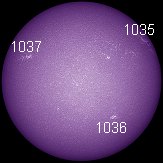
All three
of these sunspots are members of new Solar Cycle
24. The image is purple because was taken
through a violet Calcium-K filter sensitive to
the light emitted by magnetic froth around
sunspots. Image credit: Stefano Sello of Pisa,
Italy
more sunspot photos:
from Rogerio Marcon of Campinas - Brasil;
from John C McConnell of Maghaberry,
Northern Ireland;
from Pete Lawrence of Selsey, West Sussex,
UK;
from Jimmy Eubanks of Boiling Springs, SC;
from Steve Riegel of Santa Maria, CA;
from Cai-Uso Wohler of Bispingen, Germany;
from Peter Paice of Belfast, Northern
Ireland;
Current
conditions
Solar wind
speed: 328.2 km/sec
density: 1.5 protons/cm3
explanation |
more data
Updated: Today at 2345 UT
X-ray Solar
Flares
6-hr max: B2
2325 UT Dec20
24-hr: B2
2325 UT Dec20
explanation |
more data
Updated: Today at: 2340 UT
|
| 12-19-09 - Sunspot 1035
GREAT SUNSPOT:
Sunspot 1035 is putting on a
good show. There are two
planet-sized cores connected by
sinuous magnetic filaments more than
100,000 km long, all surrounded by a
seething froth of hot plasma. "It's
great," says Paul Haese, who sends
this picture from his backyard
observatory in Blackwood, Australia:

"This is the best spot of the new
solar cycle so far," he says. "I
photographed it this morning using a
Coronado Solarmax 60."
On Dec. 16th, magnetic fields
around the sunspot erupted and
hurled a coronal mass ejection
toward Earth. The billion-ton cloud
is still en route. High-latitude sky
watchers should
be alert for auroras when it
arrives on Dec. 18th or 19th.
more images:
from Matt Wastell of Paddington,
Brisbane, Australia;
from Pete Lawrence of Selsey,
West Sussex, UK;
from Fulvio Mete of Rome, Italy;
from Richard Best of Lewes,
Sussex, England;
from A. Berry and J. Stetson of
South Portland,Maine;
from John C McConnell of
Maghaberry Northern Ireland;
from Karzaman Ahmad of Langkawi
National Observatory, Malaysia;\
Current conditions
Solar
wind
speed: 425.8 km/sec
density: 0.5 protons/cm3
explanation |
more data
Updated: Today at 0655 UT
X-ray
Solar Flares
6-hr max: B5
0150
UT Dec19
24-hr: C1
0015
UT Dec19
explanation |
more data
Updated: Today at: 0645 UT
|
| 12-18-09 - Sunspot 1035
THREE DAYS ON THE SUN:
Three days ago, the
surface of the sun was calm and
almost featureless. Then sunspot
1035 burst onto the scene. A movie
from the Solar and Heliospheric
Observatory shows developments from
Dec. 14th to the present:
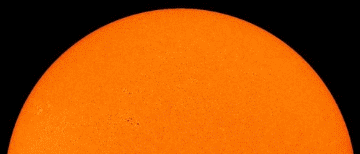
The recently invisible spot is
now nine times wider than Earth and
crackling with
C-class solar flares. A series
of eruptions on Dec. 16th sent two
and perhaps three coronal mass
ejections (CMEs) in the general
direction of our planet.
High-latitude sky watchers should
be alert for auroras when the
clouds arrive beginning on Dec. 18th
or 19th.
(updated) more images:
from Richard Best of Lewes,
Sussex, England;
from A. Berry and J. Stetson of
South Portland,Maine;
from John C McConnell of
Maghaberry Northern Ireland;
from Karzaman Ahmad of Langkawi
National Observatory, Malaysia;
from Monty Leventhal OAM of
Sydney, Australia;
from Michael Rosolina of White
Sulphur Springs, WV;
from Gianfranco Meregalli of
Milano, Italy;
from Mustafa Erol of
Antalya/Turkey;
from Fabio Mariuzza of Biauzzo,
Italy;
from Stephen Ames of
Hodgenville, KY;
Current conditions
Solar
wind
speed: 390.7 km/sec
density: 1.2 protons/cm3
explanation |
more data
Updated: Today at 0153 UT
X-ray
Solar Flares
6-hr max: B2
2020
UT Dec17
24-hr: B7
1510
UT Dec17
explanation |
more data
Updated: Today at: 2355 UT
|
12-17-09 - Sunspot 1035
Current conditions
Solar wind
speed: 414.1 km/sec
density: 1.4 protons/cm3
explanation |
more data
Updated: Today at 2344 UT
X-ray Solar Flares
6-hr max: B2
2020 UT Dec17
24-hr: B7
1510 UT Dec17
explanation |
more data
Updated: Today at: 2340 UT
|
| 12-16-09 - Sunspot
1035
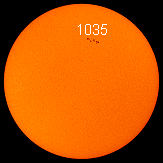
INCOMING CME:
This morning at 0120 UT, an eruption of magnetic
fields around sunspot 1035 produced a
long-duration
C4-class solar flare and hurled a coronal
mass ejection (CME) in the general direction of
Earth. High-latitude sky watchers should
prepare
for auroras when the CME arrives on or about
Dec. 18th. STEREO movies:
solar flare,
CME.
|
Scientists classify solar flares
according to their x-ray brightness in
the wavelength range 1 to 8 Angstroms.
There are 3 categories: X-class flares
are big; they are major events that
can trigger planet-wide radio
blackouts and long-lasting radiation
storms. M-class flares are
medium-sized; they can cause brief
radio blackouts that affect Earth's
polar regions. Minor radiation storms
sometimes follow an M-class flare.
Compared to X- and M-class events,
C-class flares are small with few
noticeable consequences here on Earth. |
|
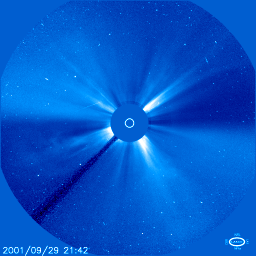
2001
Impact of a CME
When the ejection
reaches the
Earth as an ICME
(Interplanetary CME), it may
disrupt the Earth's
magnetosphere,
compressing it on the day
side and extending the
night-side
magnetic tail. When the
magnetosphere
reconnects on the
nightside, it creates
trillions of
watts of
power which is directed
back toward the Earth's
upper atmosphere. This
process can cause
particularly strong
aurora also known as the
Northern Lights, or aurora
borealis (in the Northern
Hemisphere), and the
Southern Lights, or aurora
australis (in the Southern
Hemisphere). CME events,
along with
solar flares, can
disrupt
radio transmissions,
cause power outages
(blackouts), and cause
damage to
satellites and
electrical transmission
lines.
Physical properties
A typical CME has a
three part structure
consisting of a cavity of
low electron density, a
dense core (the prominence,
which appears as a bright
region on coronagraph
images) embedded in this
cavity, and a bright leading
edge. It should be noted,
however, that many CMEs are
missing one of these
elements, or even all three.
Most CMEs originate
from active regions
(groupings of sunspots
associated with frequent
flares). These regions have
closed magnetic field lines,
where the magnetic field
strength is large enough to
allow the containment of the
plasma; the CME must open
these field lines at least
partially to escape from the
sun. However, CMEs can also
be initiated in quiet sun
regions (although in many
cases the quiet region was
recently active). During
solar minimum, CMEs form
primarily in the coronal
streamer belt near the solar
magnetic equator. During
15 g.
Due to the two-dimensional
nature of the coronagraph
measurements, these values
are lower limits. The
frequency of ejections
depends on the phase of the
solar cycle: from about
one every other day near
solar minimum to 5–6 per
day near
solar maximum. These
values are also lower limits
because CMEs propagating
away from the Earth
("backside CMEs") can
usually not be detected by
coronagraphs.
Current knowledge of
CME kinematics indicates
that the CME starts with an
initial pre-acceleration
phase characterised by a
slow rising motion, followed
by a period of rapid
acceleration away from the
Sun until a near-constant
velocity is reached. Some
"balloon" CMEs (usually the
very slowest ones) lack this
three-stage evolution,
instead accelerating slowly
and continuously throughout
their flight. Even for CMEs
with a well-defined
acceleration stage, the
pre-acceleration stage is
often absent (or perhaps
unobservable).
Current conditions
Solar
wind
speed: 349.1 km/sec
density: 3.0 protons/cm3
explanation |
more data
Updated: Today at 1846 UT
X-ray
Solar Flares
6-hr max: C3
1300
UT Dec16
24-hr: C4
0120
UT Dec16
explanation |
more data
Updated: Today at: 1845 UT
|
| 12-15-09 - Sunspot 1035 appears
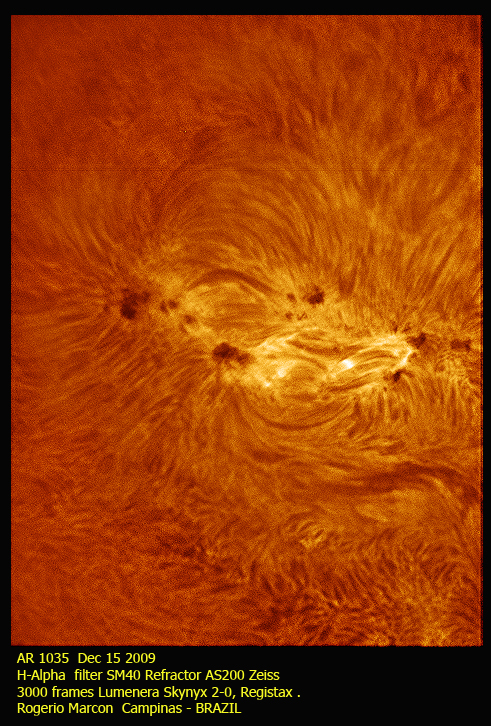
BIG NEW SUNSPOT:
New sunspot 1035 is
growing rapidly and it is now seven
times wider than Earth itself:
movie.
The magnetic polarity of
the spot identifies it as a member
of new Solar Cycle 24.
Readers with
solar telescopes, train your
optics on the sun to witness sunspot
genesis in action.
sunspot photos:
from Rogerio Marcon of Campinas,
Brazil;
from Etienne Lecoq of Normandy,
France;
from G.Harmon et al of South
Portland, Maine;
from John C McConnell of
Maghaberry Northern Ireland
Current conditions
Solar
wind
speed: 281.4 km/sec
density: 2.2 protons/cm3
explanation |
more data
Updated: Today at 2235 UT
X-ray
Solar Flares
6-hr max: B1
2125
UT Dec15
24-hr: B1
1520
UT Dec15
explanation |
more data
Updated: Today at: 2230 UT
|
12-14-09 - Sunspot 1034
Current conditions
Solar wind
speed: 265.8 km/sec
density: 1.8 protons/cm3
explanation |
more data
Updated: Today at 0844 UT
X-ray Solar Flares
6-hr max: A0
2350 UT Nov30
24-hr: A0
0125 UT Nov30
explanation |
more data
Updated: Today at: 2350 UT
|
12-13-09 - Sunspot 1034
Current conditions
Solar wind
speed: 257.9 km/sec
density: 2.1 protons/cm3
explanation |
more data
Updated: Today at 2345 UT
X-ray Solar Flares
6-hr max: A0
2350 UT Nov30
24-hr: A0
0125 UT Nov30
explanation |
more data
Updated: Today at: 2350 UT
|
12-12-09
- Sunspot 1034
Current conditions
Solar wind
speed: 287.2 km/sec
density: 5.0 protons/cm3
explanation |
more data
Updated: Today at 2343 UT
X-ray Solar Flares
6-hr max: A0
2350 UT Nov30
24-hr: A0
0125 UT Nov30
explanation |
more data
Updated: Today at: 2350 UT
GEMINID METEOR SHOWER:
Mark your calendar.
The
Geminid
meteor
shower peaks on Dec. 13th and
14th when Earth passes through a
stream of debris from extinct comet
3200 Phaethon. The Geminids have
been intensifying in recent years,
and 2009 could be the best year yet.
Forecasters expect 140+ meteors per
hour under the dark skies of a new
Moon. [sky
map]
|
12-11-09 - Sunspot 1034
Current conditions
Solar wind
speed: 248.8 km/sec
density: 1.4 protons/cm3
explanation |
more data
Updated: Today at 2344 UT
X-ray Solar Flares
6-hr max: A0
2350 UT Nov30
24-hr: A0
0125 UT Nov30
explanation |
more data
Updated: Today at: 2350 UT
NASA Comet Hunter Set For Monday
Launch
Weekend liftoff of WISE space
telescope scrubbed due to faulty
steering engine.
By
Paul McDougall
InformationWeek
December 11, 2009 02:49 PM
NASA delayed until Monday the launch of a space
telescope designed to create a
highly detailed map of the
heavens and spot comets and
asteroids that could pose a
threat to life on Earth.
NASA's Wide-field Infrared
Survey Explorer, or WISE, was
slated to lift off from
California's Vandenberg Air
Force Base atop a Delta II
rocket Friday, but a balky
booster steering engine forced
the delay.
"Mission managers have
implemented a plan to resolve
the issue," NASA said in a
statement. Crews from the space
agency will work over the
weekend to remove and replace a
suspect component, NASA said.
The forecast calls for an
80% chance of acceptable weather
for Monday's launch. Plans call
for the rocket to head south,
traverse the California
coastline, and veer out over the
Pacific Ocean.
Once in orbit, WISE will
use an infrared camera to map
the cosmos.
The mission calls for the
unmanned spacecraft to cover the
entire sky one-and-a-half times,
until its frozen coolant runs
out. NASA hopes it will capture
everything from near-Earth
asteroids to distant galaxies
teeming with stars.
"The last time we mapped
the whole sky at these
particular infrared wavelengths
was 26 years ago," noted UCLA's
Edward Wright, who is principal
mission manager.
"Infrared technology has
come a long way since then. The
old all-sky infrared pictures
were like impressionist
paintings—now we'll have images
that look like actual
photographs," said Wright.
WISE is designed to
provide information about the
size, composition, and texture
of near-Earth objects such as
comets and asteroids. "We can
help protect our Earth by
learning more about the
diversity of potentially
hazardous asteroids and comets,"
said Amy Mainzer, deputy project
scientist for the mission at
JPL.
WISE will also attempt to
document the cycle of life in
the Universe, as it will capture
faraway images of star-hatching
galaxies and ravenous,
planet-eating black holes.
Maybe it can also figure
out what those blue lights over
Norway were.
|
| 12-10-09 - Sunspot 1034 just appeared
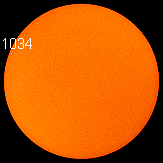
Current
conditions
Solar wind
speed: 278.0
km/sec
density: 3.0
protons/cm3
explanation
|
more data
Updated: Today
at 2345 UT
X-ray Solar
Flares
6-hr max: A0
2350 UT Nov30
24-hr: A0
0125 UT Nov30
explanation
|
more data
Updated: Today
at: 2350 UT
|
| 12-9-09 - No sunspots today

See:
http://www.greatdreams.com/ufos/norway/Norway-Blue-Beam.htm
Current conditions
Solar wind
speed: 283.1 km/sec
density: 0.4 protons/cm3
explanation |
more data
Updated: Today at 2344 UT
X-ray Solar Flares
6-hr max: A0
2350 UT Nov30
24-hr: A0
0125 UT Nov30
explanation |
more data
Updated: Today at: 2350 UT
|
| 12-8-09 - No sunspots today - but look at
this
ERUPTIVE PROMINENCE:
December
began with an enormous
magnetic filament wrapped
around the sun's south pole.
On Friday, Dec. 4th, it
erupted. NASA's twin
STEREO probes, stationed
on nearly opposite sides of
the sun, photographed the
blast from two points of
view. Click on the image to
set the scene in motion:
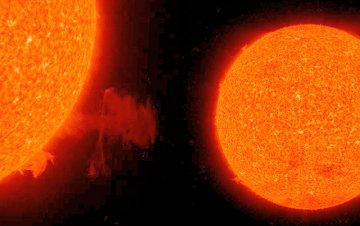
1 MB
Quicktime movie
Astronomers
have
been
monitoring
eruptive
prominences
like
this one
for
decades,
but only
now are
they
getting
the 3D
view
provided
by
STEREO.
"[In the
past],
we
really
had no
idea in
what
plane
the
center
of mass
of the
eruptive
material
was
moving,"
says Joe
Gurman
of the
Solar
Physics
Lab at
NASA's
Goddard
Space
Flight
Center.
But
look
again
at the
STEREO
movie,
particularly
at the
right-hand
image.
"The
material
is
heading
from
high
latitudes
toward
the
solar
equator,"
he
notes.
The
dynamics
of these
massive
events
are
becoming
clear at
last.
More
eruptions
may be
found in
the
STEREO
gallery.
Current conditions
Solar wind
speed: 303.5 km/sec
density: 1.1 protons/cm3
explanation |
more data
Updated: Today at 2346 UT
X-ray Solar Flares
6-hr max: A0
2350 UT Nov30
24-hr: A0
0125 UT Nov30
explanation |
more data
Updated: Today at: 2350 UT
|
12-7-09 - No sunspots today
Current conditions
Solar wind
speed: 322.6 km/sec
density: 1.5 protons/cm3
explanation |
more data
Updated: Today at 2344 UT
X-ray Solar Flares
6-hr max: A0
2350 UT Nov30
24-hr: A0
0125 UT Nov30
explanation |
more data
Updated: Today at: 2350 UT
|
| 12-6-09
FULL MOON AT NOON:
Full Moons
are opposite the sun. That's
why you can see a full Moon
at midnight, but never at
noon. It's an unbreakable
rule. On Dec. 2nd,
Brian Whittaker broke
the rule. "I photographed
the full Moon in the middle
of the day!"

He took the picture from
an airplane flying 34,000
feet above Greenland at a
latitude just south of the
Arctic Circle.
"It was lunchtime and the
sun popped up in the south
for its brief daily
appearance," he says. "I
looked due north, over the
North Pole, and there was
the Moon hanging over
Japan--a full Moon at noon!"
"It is always a pleasure
to fly through the Arctic,"
he adds. "You can see things
from such a different point
of view."
more points of
view:
from Rolando De Michiel
of Bonnet Bay, New South
Wales, Australia;
from Ernie Mross of
Boulder, Colorado;
from P-M Hedén of
Vallentuna, Sweden;
from Pete Strasser of
Tucson, AZ;
from Doug Zubenel of
Lenexa, Kansas
|
| 12-5-09 - No sunspots today:
SOLAR ACTIVITY:
Something has exploded on the
farside of the sun. Late yesterday,
Dec. 4th, a billion-ton coronal mass
ejection (CME) billowed over the
sun's western limb. Click on the
image to view a movie of the cloud
recorded by the Solar and
Heliospheric Observatory:
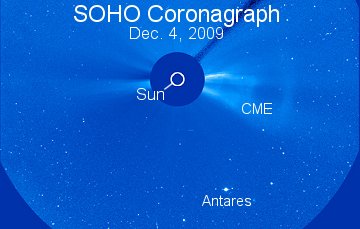
The blast site could
be one of two farside active regions
currently under surveillance by
NASA's
STEREO spacecraft, but
those active regions don't seem
to be in the right place to hurl a
CME over the sun's western limb. The
source might reveal itself in the
days ahead as the sun's rotation
turns unseen territory toward
STEREO--or toward Earth. Stay tuned.
Current conditions
Solar
wind
speed: 253.7 km/sec
density: 0.3 protons/cm3
explanation |
more data
Updated: Today at 0826 UT
X-ray
Solar Flares
6-hr max: A0
2350
UT Nov30
24-hr: A0
0125
UT Nov30
explanation |
more data
Updated: Today at: 2350 UT
|
12-4-09 - No sunspots today
Current conditions
Solar wind
speed: 249.6 km/sec
density: 0.4 protons/cm3
explanation |
more data
Updated: Today at 2121 UT
X-ray Solar Flares
6-hr max: A0
2350 UT Nov30
24-hr: A0
0125 UT Nov30
explanation |
more data
Updated: Today at: 2350 UT
SANDTRAPPED
ON MARS:
NASA
engineers
are working
mightily to
free Spirit
from a
sandtrap in
the Columbia
Hills of
Mars. During
one recent
effort on
Nov. 28th,
Spirit's
stuck wheel
turned
enough to
roll forward
1.4 meters.
The rover
itself,
however,
moved less
than a
millimeter:
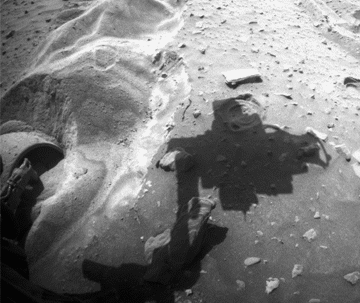
The view
from
Spirit's
front hazard
camera. Note
the stuck
wheel at
left.
In this
two-frame
animation,
the shifting
of Spirit's
shadow is
caused not
by
locomotion,
but rather
by the sun
moving
overhead.
All the
turning
really did
was churn up
more sand.
Mission
planners
expect slow,
if any,
progress
during
similar
drives in
the weeks
ahead. "The
probability
of success
in escaping
is
uncertain,"
says NASA.
On the
bright side,
the soil
Spirit is
churning up
turns out to
be "supremely
interesting,"
according to
mission
scientist
Ray Arvidson
of
Washington
University.
It is rich
in
sulfates--"minerals
formed in
steam
vents," he
explains.
"Steam is
associated
with
hydrothermal
activity –
evidence of
water-charged
explosive
volcanism.
Such areas
could have
once
supported
life." If
Spirit must
be stuck,
this is a
good place
to be. Stay
tuned for
updates on
NASA's
efforts to
Free Spirit.
|
12-3-09 - No sunspots today
Current conditions
Solar wind
speed: 254.4 km/sec
density: 0.2 protons/cm3
explanation |
more data
Updated: Today at 2319 UT
X-ray Solar Flares
6-hr max: A0
2350 UT Nov30
24-hr: A0
0125 UT Nov30
explanation |
more data
Updated: Today at: 2350 UT
ARCTIC LIGHTS:
In Tromsø,
Norway, the long polar night
has begun. The sun set in
November and it won't be
back until January. There is
still a way, however, to
catch some sun. Just hop in
a plane:

"I took this picture
flying above Tromsø at
midday on Dec. 2nd," says
Thomas Hagen. From 30,000
ft, the sun can be seen over
the northern horizon--a
welcome dose of daylight.
Darkness returned when
the plane landed, just in
time for a light show of a
different kind. A solar wind
stream is approaching Earth
and it could spark Northern
Lights when it arrives on
Dec. 3rd or 4th.
ng,
followed these instructions
on Dec. 2nd, and here is
what he saw:
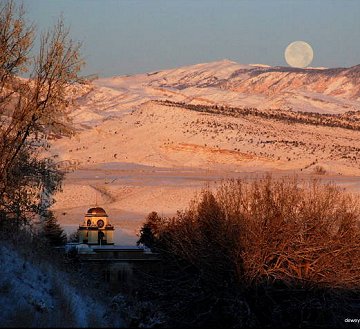
"The mountain is called
Mooncrest Peak," says
Vanderhoff. "Four inches of
snow fell overnight and the
temperature was very near 0°
F at dawn. The golden cupola
of the Park County
courthouse is catching the
day's first light at lower
left."
A repeat performance will
occur on Dec. 31st when the
second full Moon of
December--a "Blue
Moon"--returns to the
snow-covered crest at dawn.
"I hope to be there," says
Vanderhoff. It is a
nice way to begin the day.
more full moon
shots:
from Tamas Ladanyi of
Veszprem, Hungary;
from Darrell Oake of
Halifax NS Canada;
from Azhy Chato Hasan of
Erbil, Kurdistan, Iraq;
from Yuichi Takasaka of
Lumby, British Columbia,
Canada;
from Chris Allington of
Omaha, Nebraska;
from Rene M. Thibault of
Chester, New Hampshire
November Northern Lights
Gallery
[previous Novembers:
2008,
2007,
2006,
2004,
2003,
2002,
2001]
|
| 12-2-09 - No sunspots today
SOLAR
MINIMUM: The sun is in the
pits of a very deep solar minimum. Many
researchers thought the sunspot cycle had hit
bottom in 2008 when the sun was blank 73% of the
time. Not so. 2009 is on the verge of going even
lower. So far this year, the sun has been blank
75% of the time, and only a serious outbreak of
sunspots over the next few weeks will prevent
2009 from becoming the quietest year in a
century. Solar minimum continues.
Sandtrapped Rover Makes a Big Discovery
12.02.2009
December 2, 2009: Homer's
Iliad tells the story of Troy, a city
besieged by the Greeks in the Trojan War.
Today, a lone robot sits besieged in the
sands of Troy while engineers and scientists
plot its escape.
Welcome to "Troy" – Mars style. NASA's
robotic rover Spirit is bogged down on the
Red Planet in a place the rover team named
after the ancient city.
So why aren't scientists lamenting?
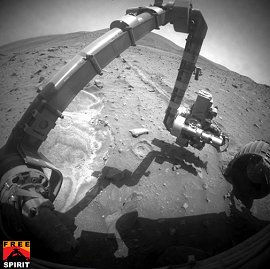
"The rover's spinning wheels have broken
through a crust, and we've found something
supremely interesting in the disturbed
soil," says Ray Arvidson of the Washington
University in St. Louis.
Spirit, like its twin rover Opportunity, has
roamed the Red Planet for nearly 6 years.
During that time, the rover has had some
close calls and come out fighting from each.
In fact, it's been driving backwards since
one of its wheels jammed in 2006.
Spirit surveys its
own predicament. The bright soil pictured
is loose, fluffy material churned by
the rover's left-front wheel as Spirit,
driving backwards, broke through a darker,
crusty surface. Above is the
least-embedded of the rover's six wheels. [larger
image]
From the beginning, the rovers' motto has
been "follow the water." Both rovers have
been searching Mars for minerals formed in
the presence of H2O. Mars appears
dry today, but minerals can provide clues
that water was once there.
"It's been easy for Opportunity to find such
minerals," explains Arvidson. "Opportunity
landed in an ancient lake bed. Spirit has
had to work much harder. Spirit landed in
basaltic plains formed by lava flows chewed
up by repeated meteoroid impacts. There's
been little evidence of anything that was
ever very wet."
But when Spirit reached an area of Mars
called the "Columbia Hills," the whole
complexion of the mission changed. "Spirit
came across iron hydroxide, a mineral that
forms in the presence of water. That alerted
us to the change. We started coming across
more and more rocks formed in the presence
of water."
Then Spirit got stuck in a patch of loose
soil on the edge of a small crater. Heavy
sigh. Stuck again.
But wait!
"Spirit had to get stuck to make
its next discovery," says Arvidson.
As the rover tried to break free, its wheels
began to churn up the soil, uncovering
sulfates underneath.
"Sulfates are minerals just beneath the
surface that shout to us that they were
formed in steam vents, since steam has
sulfur in it. Steam is associated with
hydrothermal activity – evidence of
water-charged explosive volcanism. Such
areas could have once supported life."
"And most amazingly, the boundary between
the sulfate-rich soil and the soil with just
the generic concentration of sulfates runs
right down the middle of the stranded rover.
Spirit is lodged on the edge of a crater --
sitting astride the boundary!"
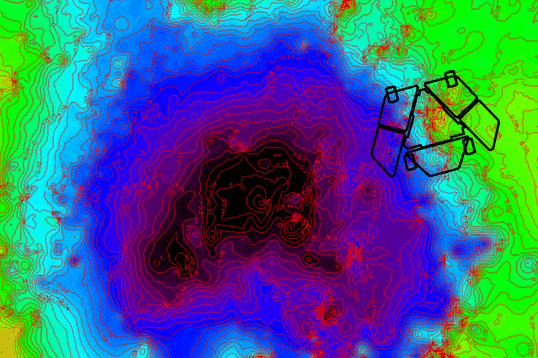
Above: A topographic map of
Spirit's surroundings at Troy. Spirit is
straddling the edge of a small crater.
Sulfate materials are located in the crater
(from the middle of the rover and extending
to the left). The topo map was generated
from stereo images taken by Spirit's
navigation camera when it was approaching
the area in April 7, 2009.
"Also, the robot found that the top of the
sulfate material is crusty. Ancient sulfates
probably formed this crust as they were
processed by variations in climate
associated with changes in Mars' orbit over
millions of years."
Here's what the scientists think: When a
Martian pole faces the sun in Martian
summer, it gets warmer at that pole and the
water ice shifts to the equator. It even
snows there! Warm dark soil under the snow
causes the bottom layer of snow to melt. The
water trickles into the sulfates, dissolving
the water-soluble iron sulfates and forming
a crust with the calcium sulfates remaining.
"By being stuck at Troy, Spirit has been
able to teach us about the modern water
cycle on Mars." Indeed, Spirit's saga at
Troy has given scientists material evidence
of past water on Mars on two time scales:
ancient volcanic times, and cycles ongoing
to the present day.
"We've sat here for more than 6 months.
That's a long time to take measurements.
We've learned a lot. Troy is a good place to
be under siege, but we’re ready to leave."
Will Spirit break free to continue its
incredible journey? Tune in to Science@NASA
to find out if the escape plan works.
Author:
Dauna Coulter | Editor:
Dr. Tony Phillips | Credit:
Science@NASA
footnotes and more information
Spirit and Opportunity home page
-- NASA's Jet Propulsion Laboratory
manages the rovers for NASA's Science
Mission Directorate in Washington.
Can Spirit be Freed? --
(Science@NASA)
A Mars Rover Named "Curiosity" --
read about NASA's next Mars rover in a
story from Science@NASA
A Tale of Planetary Woe --
(Science@NASA) Long ago, something
calamitous happened to Mars,
transforming a hospitable world into the
apparently lifeless desert we see today.
Many scientists believe the Red Planet
lost most of its atmosphere, but how? A
new NASA mission named MAVEN is
specifically designed to answer that
question.
|
12-1-09 - No sunspots today
Current conditions
Solar wind
speed: 265.2 km/sec
density: 1.3 protons/cm3
explanation |
more data
Updated: Today at 2344 UT
X-ray Solar Flares
6-hr max: A0
2350 UT Nov30
24-hr: A0
0125 UT Nov30
explanation |
more data
Updated: Today at: 2350 UT
LONG
NIGHT'S
MOON:
There's a
full Moon
tonight and
according to
folklore it
has a
special
name--the
Long Night's
Moon. Most
Decembers
have just
one full
Moon, but
this
December
will have
two. The
Long Night's
Moon of Dec.
1st-2nd will
be followed
by a full
"Blue Moon"
on Dec.
31st. Stay
tuned for
more
information
about the
Blue Moon as
the end of
the year
approaches.
RARE MOON HALOS:
On Nov. 29th, when the waxing Long Night's Moon ascended over Kittilä, Finland, Timo Veijalainen walked outside and witnessed a once-in-a-lifetime moonrise. "I saw this weird halo," he says. "It didn't start out so bright, but later it intensified and formed a number of different rings. I've never seen anything it!"
Fortunately, he was not too spellbound to take a picture:
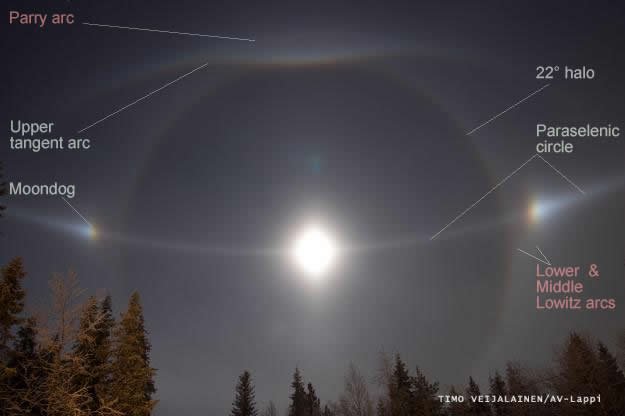
The display was caused by ice crystals floating in the air between Finland and the Moon. Moonlight glinted, reflected, and refracted through the crystals in a complicated pattern that produced a display of surpassing beauty.
Atmospheric optics expert Les Cowley was so impressed, he waxed poetic in describing the scene: "Halos like this around Helios, the ancient Greek sun god, would be notable. Around much fainter Selene, the moon goddess, they are outstanding. We need new names for some of them. On each side of Selene there is a bright and colorful moondog or 'paraselene.' The white halo joining them and passing through the moon is a 'paraselenic circle.'"
"But the two choicest gems illuminated by Selene keep their old names. The very topmost halo is a rare one. It remains a Parry arc in honor of its discoverer the Arctic explorer William Parry, who first saw it around the sun. That's not all. The smudges near the moondogs are very rare lower and middle Lowitz arcs. These were not even photographed around Helios until the 1990s!"
more Moon halos: from Mustafa Erol of Antalya, Turkey; from Max Bittle of Suncook, New Hampshire; from Ethan Tweedie of Brownwood Texas
|
SPACE DATABASE ON THIS SITE
DREAMS OF THE GREAT EARTHCHANGES -
MAIN INDEX
|







 *
*


















